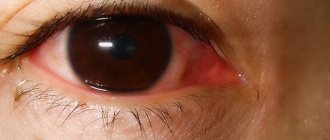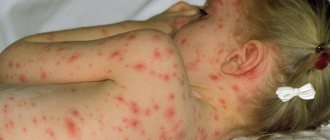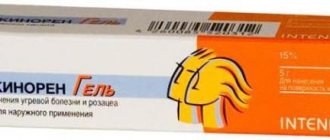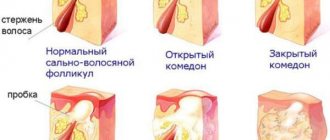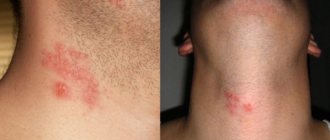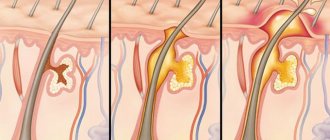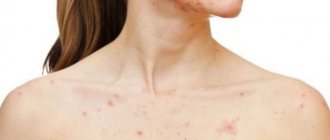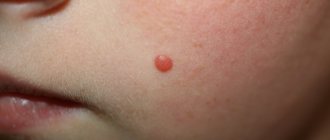In some patients, the process involves the eyelids and eyes, and ocular symptoms may be the main ones. In some cases, there is thickening and deformation of the skin (phyma). In general, rosacea is more common in women, but phymatous forms of the disease are more common in men. Vivid manifestations of rosacea, localized in an open area of skin that is extremely important for communication, cause significant psychological discomfort.
The pathogenesis of rosacea is still being actively studied, but still remains poorly understood. In the development of the disease, disturbances of local immunity, neurovascular regulation, and skin barrier function are important; the role of microorganisms (Demodex folliculorum, Staphylococcus epidermidis, Helicobacter pylori, Bacillus oleronius) is currently being clarified.
There are several treatment options for rosacea, but currently none of them are universal. Over the course of a person's life, their response to treatment may change. The disease can often be controlled, but not cured. Therefore, the main goals of therapy are to correct symptoms, maintain the achieved result, prevent relapses, improve the quality of the skin and the patient’s quality of life.
In this article, we will look at the three most important components of rosacea treatment: patient education, skin care, and the use of pharmaceuticals.
Facial rosacea diagnosis and symptoms
Facial rosacea is a persistent and often chronic condition in which the skin on the cheeks, nose, chin and eyes becomes inflamed and red, forming small pimples and visible blood vessels.
Rosacea is diagnosed after a physical examination of the patient's skin, questioning, and medical history. At the same time, it is necessary to clearly differentiate from similar problems - rosacea, acne, allergies and demodicosis.
While it is very difficult to determine the exact cause of rosacea, the main symptom is redness of the skin on the face (especially on the nose and cheeks), to which are added confounding factors such as visible dilated blood vessels and inflammation.
So, typical symptoms of rosacea will be a combination of any several factors from this list:
- redness of the skin, especially on the cheeks and nose
- inflamed bumps on the cheeks and chin, similar to pimples
- small networks of visible blood vessels on the face
- tendency of the skin to become red or break out frequently
- burning or tingling sensation in the skin of the face
- rough texture of the skin surface, sometimes with an orange peel effect
- About half of people with rosacea also complain of frequent redness and irritation of the eyelid skin, which leads to inflammation of the inner eyelid
How to take Unidox Solutab for prostatitis?
Have you been trying to cure PROSTATITIS for many years?
Head of the Institute: “You will be amazed at how easy it is to cure prostatitis by taking it every day...
Read more "
Tetracycline antibiotics are widely used to eliminate inflammation in the prostate gland. They act on microbial proteins, reducing their formation. Therefore, bacteria stop growing and multiplying.
One of the frequently prescribed remedies is Unidox Solutab for prostatitis. It affects a large number of bacteria. Therefore, the drug is prescribed for various forms of disease.
Composition and release form
Unidox Solutab is an antibiotic that belongs to the tetracycline group. It is used in the treatment of prostatitis of both acute and chronic types.
Unidox Solutab is available only in tablet form
The active ingredient of the drug is doxycycline. In addition, the composition contains various substances that enhance the properties of the antibacterial component. In addition, the product is created with the addition of various fillers.
Unidox Solutab has a single release form - tablets. Each of them has a light yellow tint and an unpleasant-tasting shell. The pill is engraved with numbers. They indicate the serial number of the product.
Operating principle
Unidox Solutab is used for prostatitis, as well as other diseases accompanied by an inflammatory process. Inhibition of pathogenic microorganisms occurs by eliminating the possibility of protein production in cells.
If the drug is taken for a long time, the pathogenic microflora becomes immune to the active substances. Then the medicine stops working, and the bacteria continue to multiply.
Concentration of the drug in various tissues of the body
Indications for use
The drug should be prescribed exclusively by a doctor. The urologist must also monitor the patient’s condition during therapy. If you take Unidox Solutab on your own, various negative consequences may appear.
There are some indications for the use of the drug.
- Reception can be carried out in the presence of acute and chronic prostatitis caused by infectious damage to organs located in the pelvis. Therefore, the antibiotic does not eliminate the symptoms of the disease. It only affects microorganisms that provoke the appearance of prostatitis. Therefore, abacterial forms of the disease cannot be cured with Unidox.
- An antibiotic can be used for sexually transmitted infections. It fights prostatitis pathogens such as gonorrhea, chlamydia, and ureaplasma. They are increasingly becoming the cause of the inflammatory process in the prostate gland.
- Treatment with Unidox can be prescribed if bacteria have spread from various infected organs, soft tissues, systems into the prostate.
Use of the drug
Unidox Solutab is prescribed for the inflammatory process in the prostate gland for a course of 5–10 days. If prostatitis is bacterial in nature, then a man needs to take 100 mg of the active substance twice a day for a week. Reception is carried out during breakfast and dinner.
Regimen for taking Unidox Solutab
In the presence of mycoplasmosis and chlamydia, the spread of harmful microorganisms is eliminated. Full recovery occurs within a short period of time.
However, an important feature of treatment is highlighted: the medication must be taken by both partners. If therapy is carried out only by a man, it will not give results. After all, the woman will remain a carrier of the infection.
During the treatment period, it is necessary to maintain sexual rest. Sexual contacts, even protected ones, are prohibited until tests are taken that confirm the absence of infection.
Contraindications
Unidox Solutab is a powerful antibiotic. Therefore, it affects not only harmful, but also beneficial microflora. A list of contraindications to the use of the product is provided.
IT IS IMPORTANT TO KNOW! D. Pushkar told how to defeat prostatitis at home...
Such a pleasant treatment for prostatitis for 147 rubles...
- The antibiotic is not prescribed to men who have hypersensitivity to the components of the drug and an allergic reaction to the active substance.
- The use of antibiotics is prohibited for patients who suffer from kidney and liver diseases. This is due to the fact that the drug leaves the body in its original form during urination.
- Patients with pathologies of the gastrointestinal tract should be careful when taking it. After all, the antibiotic helps to suppress the beneficial intestinal microflora. If it is impossible to refuse use, you must additionally take probiotics to normalize digestion.
Adverse reactions
If the dosage prescribed by the doctor is exceeded, various negative changes may occur. Among them are:
- sudden weight loss;
- nausea and vomiting;
- diarrhea;
- rashes on the skin;
- dysfunction of the thyroid gland;
- hemolytic anemia;
- dizziness, headache;
- decreased visual acuity.
Reviews
Feedback from patients after taking the drug is contradictory. On the one hand, it eliminates the influence of harmful microorganisms. On the other hand, Unidox Solutab has a large number of side effects that negatively affect the condition of the body.
Originally posted 2017-01-30 10:03:10.
Rosacea treatment regimen
Rosacea is a chronic condition of skin inflammation, which means it is indolent. There is no specific treatment regimen for rosacea; there are many different options, where lifestyle changes, skin care and medical procedures play a huge role.
Russian dermatology has a classic treatment regimen for rosacea. These are antibiotics inside and outside (most often metronidazole), retinoids (Roaccutane), external therapy.
External therapy is usually as follows: creams, gels, ointments containing azelaic acid, metronidazole 0.75% and 1%, adapalene 0.1% and gel with metronidazole 1%, pimecrolimus 1% cream, clinadamycin. Long-term use is required, often several months.
Historically, ointments and pastes containing ichthyol, sulfur and tar were used. They are still used today due to their budget price, but the problem with these products is the local irritating effect on the skin and the destruction of the skin barrier, as a result of which the skin becomes thinner and the risk of infection with staphylococcus and other pathogenic flora increases, worsening the condition of the skin.
I personally encountered a perverted version of the “classical treatment regimen” and confusion in diagnosing rosacea, which I wrote about on my blog.
After talking with modern doctors, I realized that such schemes injure the skin and worsen its condition, making it defenseless and thin. And you need to look for other methods of treating problem skin. American dermatologists say the same thing, preferring procedures aimed at soothing the skin and boosting its immunity rather than destroying it.
Factors complicating the course of the disease
Among the accompanying factors that can provoke the appearance of rosacea and aggravate its course, a significant place is occupied by:
- adverse effects of climatic conditions, for example, intense UV radiation, excessive heat, frost, traumatic effects of wind or dust;
- use of irritating cosmetics/procedures (peelings, waterproof cosmetics removers, “hot” masks, etc.);
- menopausal syndrome;
- systemic medications that increase erythema;
- consumption of spicy foods, strong drinks, overeating, and other factors that cause a rush of blood to the face.
It is worth noting that identifying and eliminating these factors greatly facilitates the process of treating rosacea and accompanying symptoms of blepharitis.
The influence of demodex mites on the development of rosacea
When culturing skin scrapings for rosacea, both the most common inhabitants of the facial skin (as in healthy people) and pathogenic microorganisms can be determined, this can be Staphyloccus aureus, gram-negative bacteria, etc. Pathogenic microorganisms are not always found in rosacea. Therefore, antibiotic treatment should be carried out only if microorganisms are detected by culture.
Demodex mite (Demodex follculorum) is often found in healthy people without signs of rosacea and is considered a normal inhabitant of the skin. And it is often not detected in patients with rosacea. Therefore, unequivocally blaming him for rosacea has long been no longer considered correct. So, rosacea and demodicosis are by no means synonymous. But in some cases they can be combined and then external gels with metronidazole are additionally prescribed.
Warning
There is no way to prevent rosacea, but symptoms can be reduced by identifying common triggers: hot drinks, alcohol, spicy foods, stress, sun exposure, and excessive heat or cold.
These conditions increase blood flow and cause small blood vessels to dilate. If you have rosacea, try to identify your specific triggers and try to avoid them completely. To cleanse and moisturize your face, you should choose beauty products that don't sting, irritate, or cause redness when applied. You should wash your face with warm water and mild soap and use your fingertips to gently massage your face. You should avoid toners, scrubs, exfoliators, and products that contain alcohol or acetone. Hydroxy acids and tretinoin may increase skin sensitivity to the sun and may worsen rosacea. Sunscreens should be used regularly and generously to protect the face. Use sunscreen with an SPF factor of 15 or higher.
Contraindications
Unidox cannot always be used to treat severe acne. The instructions indicate the following contraindications to this drug:
- Do not use if there is impaired functioning of the liver or kidneys;
- Strictly contraindicated for use by children under 8 years of age;
- It is not recommended to use when carrying a child, the active substance penetrates the placenta and can cause developmental disorders in the child;
- Cannot be used when breastfeeding a child, the constituent components penetrate into breast milk;
- If you have hypersensitivity to the constituent elements.
It is not recommended to combine taking an antibiotic with drinking alcohol. The fact is that alcohol can cause a large number of side effects, some of which can cause serious health problems.
Instructions for use
The drug is intended for oral use. The tablets can be swallowed whole, chewed and washed down, or pre-dissolved in water, for which a small amount (from 20 ml) is sufficient. It is recommended to take the resulting suspension while sitting or standing long before bedtime.
How to take it correctly against acne?
To treat acne, Unidox Solutab is recommended to use 1/2–1 tablet per day. The instructions indicate that the drug should be taken not before or after meals, but during meals, in order to reduce the negative effect on the gastric mucosa. It is also possible to take the tablets with milk. When treating adolescents, the dosage remains the same. The course of treatment lasts from 2 weeks to several months.
